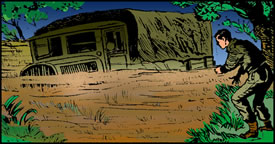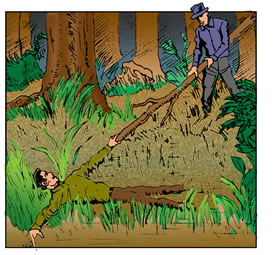
Dimdima
Online Children's Magazine from India

Dimdima
Online Children's Magazine from India

Once during World War II, a convoy of trucks was attacked by Nazi bombers in Belgium, forcing one of the truck drivers, Corporal Roger Jonas of the U.S. army, to swerve into what he thought was a muddy field.
He felt his truck lurch and when he tried to open the door found that it was jammed shut. He poked his head out of the window and saw to his dismay that the truck was slowly sinking into the mud. The mud was almost halfway up the door. He climbed out of the window and onto the roof. The mud kept on rising.
Jonas began to panic. He realised that he had been caught in quicksand. Now he hardly heard the bombs bursting around him. All he could hear was the weird sucking noise the sand was making as it swallowed more and more of his truck.
 Jonas climbed onto the tarpaulin-covered cargo and watched in terror as the sand began to inch upward towards him.
Jonas climbed onto the tarpaulin-covered cargo and watched in terror as the sand began to inch upward towards him.
When it touched his feet, he felt as if death were reaching out for him. With a strangled cry he leapt for the road but fell short and sank to his knees. Frantically diving forward, he managed to grasp a tuft of grass. Mercifully the roots held and he pulled himself out of the trap.
When he had gained the safety of the road he turned to look at his truck and found that it had vanished.
Like Jonas, many other soldiers encountered quicksand in the battlefields of Europe and Asia. Their experiences made scientists curious about the nature of quicksand and several studies were launched.
Today we know that quicksand is a mass of fine sand saturated with upward flowing water. This results in a soft, semi-liquid and unstable mass that yields under pressure. Quicksand that consists of thick layers of sand is dangerous to anyone who blunders into it.
A person falling into quicksand should lie flat on his back with arms stretched out at right angles to the body. In this posture the body will float. Then the person can either wait for help to arrive or gently roll towards firm ground.
EXPLORE MORE...
Get Help or Give Help.
- Do you have a Science Question?
- Post it here and get the answer.
- Some questions posted by others are not yet answered.
- View those questions and answer them.
Dimdima is the Sanskrit word for ‘drumbeat’. In olden days, victory in battle was heralded by the beat of drums or any important news to be conveyed to the people used to be accompanied with drumbeats.
Bharatiya Vidya Bhavan
K. M Munshi Marg,
Chowpatty, Mumbai - 400 007
email : editor@dimdima.com
Bharatiya Vidya Bhavan
505, Sane Guruji Marg,
Tardeo, Mumbai - 400 034
email : promo@dimdima.com
Dimdima.com, the Children's Website of Bharatiya Vidya Bhavan launched in 2000 and came out with a Printed version of Dimdima Magazine in 2004. At present the Printed Version have more than 35,000 subscribers from India and Abroad.